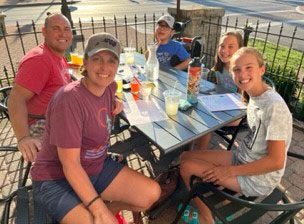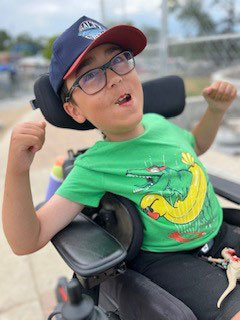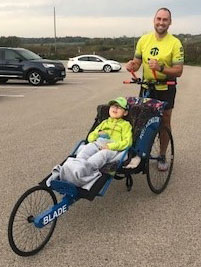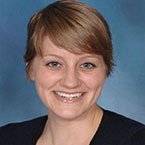By: Jenna Klotz, MD, MS, FAAP
Muscular dystrophies are genetic muscle disorders which cause progressive muscle weakness. There are more than 40 different types. Symptoms can be present at birth or may not occur until adolescence or adulthood. Similarly, muscle weakness can progress at different rates. Here's what families need to know.
What causes muscular dystrophy?
Muscular dystrophies are caused by abnormalities in proteins that are important for the structure and function of muscle. These abnormalities are caused by genetic changes, which can be inherited or can be a new change found only in the affected person.
When you move, your muscle fibers contract and stretch, which puts stress on the muscle. In healthy muscles, the muscle can withstand this physical stress and heal itself when injured. However, with muscular dystrophy, the muscle fibers have abnormal structure or function; even routine physical activity can injure the muscles and the muscles do not heal as they should. Over time, this causes progressive muscle loss and weakness.
What are the different types of muscular dystrophy?
The most common types of muscular dystrophies in children are
Duchenne muscular dystrophy (DMD) and
Becker muscular dystrophy (BMD). DMD and BMD are caused by mutations in
dystrophin which is located on the X chromosome. DMD affects 1 in about 5000 males. Although primarily males are affected, females can have symptoms, particularly related to the heart muscle.
Duchenne muscular dystrophy
Males with DMD may have borderline delays in gross motor skills in the first 1-2 years of life. Symptoms typically become more apparent between 3-5 years old, when they may have more falls than typical for their age. They may also have difficulty walking up and down stairs and standing up from the floor. In addition, they may appear to "waddle" when they walk and can have enlarged calf muscles. Children with DMD typically lose the ability to walk in their early teenage years and pass away in their 20s to 40s. This is because of weakness in their breathing muscles (respiratory failure) or abnormalities in their heart muscle (cardiomyopathy).
Becker muscular dystrophy
Becker muscular dystrophy (BMD) generally has less severe muscle weakness, later onset and slower, less predictable progression. However, the heart muscle can be affected like it is with DMD. In some cases of BMD, cardiomyopathy causing heart failure may be the first sign with little to no apparent limb weakness.
Other types of muscular dystrophy
Limb girdle muscular dystrophy (LGMD): In LGMD, muscle weakness starts in the muscles closest to the center of the body, including the hips, pelvis, shoulders, upper arms and legs. Over time, weakness can spread to other muscles. There are over 25 types of LGMD.
Facioscapulohumeral muscular dystrophy (FSHD): In FSHD, the earliest muscles with weakness include those in the face, shoulder and upper back, lower abdomen, and lower leg. Shoulder blades may appear to stick out ("winged scapula"). Weakness can be asymmetric (different on each side of the body) and usually progresses slowly. Most individuals with FSHD develop symptoms in adolescence or early adulthood. However, 5% to 10% have symptoms before age 10.
(Parents: if your child is affected by FSHD, share with them "Strength Isn't Just Physical," below.)
Myotonic Dystrophy: Myotonic dystrophy is the most common muscular dystrophy in adults but can also affect newborns and children. Newborns with myotonic dystrophy have low muscle tone and weakness at birth and typically need support for breathing and feeding. This often improves over time before they develop increased muscle weakness in later teenage years and difficulty relaxing muscles (myotonia). Intellectual disability is common. People with childhood-onset myotonic dystrophy may have learning or cognitive issues as their primary symptom and later develop muscle weakness and myotonia.
Congenital muscular dystrophy: Children with congenital muscular dystrophy have low muscle tone and weakness at birth. (See "Parent to Parent," below.) Kids with some types of congenital muscular dystrophy may have abnormal brain structure on MRI, abnormal eye structure and sometimes
seizures.
Emery-Dreifuss muscular dystrophy (EDMD): Individuals with EDMD typically develop symptoms between 5-10 years old. They develop contractures (stiff or fixed joints), followed by slowly progressive weakness in their upper arms and lower legs. Later, they develop weakness in their shoulders, pelvis, and hips. Heart failure and
abnormal heart rhythms are common and usually start after age 20.
Collagen-related muscular dystrophy: Collagen is a major component of connective tissue, which provides support for joints, skin and other structures in the body. So, children with collagen-related muscular dystrophy may have contractures (fixed joints) or overly flexible joints (hyperlaxity) early on. They can also have hyperkeratosis (bumpy, dry skin), very soft skin on their palms and soles, and poor wound healing. Ullrich congenital muscular dystrophy is the most severe form, with signs shortly after birth. Bethlem myopathy is the mildest form with slowly progressive weakness starting in childhood or early adulthood. There are also intermediate forms.

Building a Community of Support
By: Stephanie & Jon Betts
 Our son, Henry James, came into the world at 37 weeks, just under 6 pounds, with a distinctly weak, chirping cry. To this day, he is still our "baby bird."
Our son, Henry James, came into the world at 37 weeks, just under 6 pounds, with a distinctly weak, chirping cry. To this day, he is still our "baby bird."
As parents of two, we were familiar with the joy and anxiety that come with having a new baby. While those new parent concerns were calmed by our experience with Henry's sisters, we also noticed some differences very early on.
Tummy time was a battle that Henry never won. Rather than lifting his head up, he would cry himself to sleep. He would take ages with a bottle, often growing too tired to even finish. When we picked Henry up under his armpits, it felt like he was going to slide right through our hands.
At a 3-month checkup, it became clear that this was more than Henry just progressing on his own time. Our pediatrician gave us the option to pursue testing immediately or wait, and we didn't hesitate to proceed with testing right away. We wanted to know what Henry was dealing with so he didn't have to continue struggling on his own.
Henry's neurologist tested his blood for high protein, a symptom of muscular dystrophy. Results showed that Henry had a protein level of over 90 times the typical amount. It was devastating to hear, but also also a relief. Over the next few weeks, Henry's diagnosis became
Congenital Merosin-Deficient Muscular Dystrophy. We were still fearful, but grateful to know what we were dealing with and began building a support system.
 Since that diagnosis, Henry's health journey has been punctuated by challenges big and small. He's had multiple hospitalizations for pneumonia, broken bones, and surgeries to lengthen his hamstring muscles, set his femurs and rebuild his hip joints. He's had sleep and swallow studies, breathing treatments and cough assist machines. But he's also had overwhelming support from his medical team. Henry is genuinely excited to see the specialists he works with, and they hold a special place in our hearts too.
Since that diagnosis, Henry's health journey has been punctuated by challenges big and small. He's had multiple hospitalizations for pneumonia, broken bones, and surgeries to lengthen his hamstring muscles, set his femurs and rebuild his hip joints. He's had sleep and swallow studies, breathing treatments and cough assist machines. But he's also had overwhelming support from his medical team. Henry is genuinely excited to see the specialists he works with, and they hold a special place in our hearts too.
Despite his health challenges, Henry makes friends easily and his wheelchair and physical limitations have never been an issue with his peers. Henry's big sisters, Grace and Claire, are loving and helpful even when he is being annoying in a way only the youngest child can. We are extremely fortunate to be surrounded by a community that cares for Henry and us.
This community includes the Muscular Dystrophy Association (MDA) and their running group,
Team Momentum. They've been there as we've moved to a more accessible home, purchased a ramp-equipped van and navigated the challenges of travel with a power wheelchair. We lean on this group often, and we simply couldn't do it without them.
 Parenting, especially if you have a child with a disability, is filled with wondering, "Am I handling this properly?" One of the biggest challenges we've found is extending grace towards ourselves and finding time for
self-care. This is essential for us to be fully present for our children and is a process we work towards each day.
Parenting, especially if you have a child with a disability, is filled with wondering, "Am I handling this properly?" One of the biggest challenges we've found is extending grace towards ourselves and finding time for
self-care. This is essential for us to be fully present for our children and is a process we work towards each day.
To families who find themselves on the path we started over 10 years ago, we have simple advice: First, build your community. Accept support and ask for help. Second, know that you can never advocate too strongly for your child. You are their voice. Be proactive and speak up for what they deserve. Remember, you are not alone.
Henry James Betts is pictured above with his family, in his power chair, and with his dad, preparing to run a marathon. The Betts family would like to extend their gratitude towards the medical specialists, school staff, aides, family, friends and so many others who make up their loving community of support.
How do I know if my child has muscular dystrophy?
In addition to muscle weakness and delay in
motor skills, children with muscular dystrophy often have high levels of creatine kinase (CK). CK is a muscle enzyme, which can be detected with a blood test.
Genetic testing is often able to confirm the diagnosis of muscular dystrophy. However, additional testing, such as electrical tests of the nerves and muscles (EMG and nerve conduction studies), muscle MRI and muscle biopsy may be necessary for some children.
What other challenges can people with muscular dystrophy have?
Respiratory muscle weakness: Muscles of the chest wall and the diaphragm are important breathing muscles and can become weak. This also causes the chest wall to become stiff, which can further worsen breathing function. Some individuals with muscular dystrophy need breathing support or ventilators only when sleeping, while others need it continuously. In addition, they can have a weak cough, making it harder for them to clear mucus. Their pulmonologist (lung specialist) may recommend additional treatments and devices to help them cough more effectively.
Heart muscle or heart rhythm abnormalities: Cardiomyopathy, or abnormal pumping and function of the heart muscle, occurs in certain types of muscular dystrophy and can lead to heart failure. Abnormal heart rhythms (arrhythmias) can also occur.
Scoliosis and contractures: Individuals with muscular dystrophy can develop joint deformities called contractures, in which the joint becomes stiff or fixed. They may also have progressive curving (scoliosis) or rigidity in their spine. Contractures and scoliosis impair their mobility further and scoliosis can contribute to breathing difficulties.
Swallowing and speech problems: The muscles used for swallowing and speaking can also become weak. Some children may need a feeding tube or adaptive communication devices.
Learning and social challenges: Some children with muscular dystrophy have learning differences, autism, attention deficit hyperactivity disorder or developmental delays outside of those from muscle weakness. These children may benefit from having special education or other educational support services to optimize their learning.
Are there treatments available for muscular dystrophy?
All children with muscular dystrophy should have a multi-disciplinary care team. This team should include rehabilitation medicine specialists (for physical, occupational and speech therapies), neurologists, pediatricians and often pulmonologists, cardiologists, orthopedics, dietitian and gastroenterologists. School support services are also key.
The first gene therapy treatment for DMD has been
approved by the U.S. Food & Drug Administration. This treatment is given as a single intravenous (through a vein) dose and was approved after
clinical trials.
For DMD, there are additional treatments that slow progression of the disease. Steroids delay the loss of the ability to walk. Steroid medications may also help preserve arm strength and respiratory muscle strength, even for people dependent on wheelchairs. For certain types of DMD, there are additional treatments called "exon-skipping" medications which can help increase the amount of dystrophin protein in the muscle.
Steroids are sometimes used in other types of limb girdle muscular dystrophy. There are some medications that can be helpful for muscle and non-muscle symptoms seen in myotonic dystrophy.
There is lots of active research into therapies for muscular dystrophies, and there may be additional muscular dystrophy treatments available in the future.

Strength Isn't Just Physical
By: Abby Svoboda
 High school is
tough. There's pressure to figure out your future and fit in. As I personally learned, most people feel self-conscious. When I was in high school, I became extremely self-conscious of the way I walked, and it took years to learn why and to accept it.
High school is
tough. There's pressure to figure out your future and fit in. As I personally learned, most people feel self-conscious. When I was in high school, I became extremely self-conscious of the way I walked, and it took years to learn why and to accept it.
I joined the tennis team and started to enjoy running too. I began running regularly, eager to get a few miles in before or after school. During this time, I began experiencing shoulder, back and hip pain that my doctor wrote off as growing pains. I figured I hadn't been working hard enough and pushed myself to do better.
A year later, my pain was increasing. I had become a significantly slower runner, and the way I walked started to change. People asked if I'd hurt my knee or ankle and friends harmlessly teased me. It became obvious that this was not just growing pain and during my sophomore year, I was diagnosed with a type of muscular dystrophy called Facioscapulohumeral Dystrophy (FSHD).
Knowing the cause of my pain and weakness was a relief, but my diagnosis presented new challenges. There were no treatments for FSHD on the horizon and it was a progressive disease. I was told things would get harder, and they did. But I was incredibly fortunate to have wonderful parents who did anything to help me, along with a strong support system of family and friends.
My support system helped me stay optimistic as I endured the physical and emotional challenges of growing weaker. I had many hard days that often made it difficult to stay positive. Progress in neuromuscular disease research and treatments kept me hopeful.
In 2019, I began participating in a clinical trial aimed at stopping the expression of the gene that causes FSHD. The trial was not a silver bullet, and it has not dramatically changed my condition. However, it is an incredible step in the right direction. Until an effective treatment for FSHD is found, I continue using the tools available to me to manage it and live a happy life filled with loving family and friends, a fulfilling career, fun hobbies and big dreams.
I often wonder how life would have unfolded without this curveball, and I would be lying if I said I didn't often wish it was not a part of my life. But while this part of my life is hard and uncertain, it has shaped me into the person I was meant to be. My own limitations have helped me become more patient and understanding with others, and the occasional ignorant comment has shaped me into a strong self-advocate. Most importantly, FSHD has shown me how resilient I am, and that strength is not always physical.
Abby Svoboda, pictured above with her fiancé, Michal, is a communications professional who is passionate about improving accessibility and inclusion for people with disabilities. She lives in Chicago and enjoys biking, visiting new restaurants and spending time with her friends and family.
Finding resources & support
Being diagnosed with muscular dystrophy can be overwhelming for children and their families. Your doctors and healthcare team are there to support you and your child. There are many
organizations and
support groups for muscular dystrophy. Supportive care extends the life of people with muscular dystrophy and there is hope for additional treatments in the near future.
More information
About Dr. Klotz
 Jenna Klotz, MD, MS, FAAP is a pediatric neurologist and neuromuscular specialist at Stanford Children’s Health/Lucile Packard Children’s Hospital and clinical assistant professor of neurology at Stanford University School of Medicine. She is a member of American Academy of Pediatrics (AAP) California Chapter 1 and the AAP Section on Neurology external affairs and publications subcommittee. Jenna Klotz, MD, MS, FAAP is a pediatric neurologist and neuromuscular specialist at Stanford Children’s Health/Lucile Packard Children’s Hospital and clinical assistant professor of neurology at Stanford University School of Medicine. She is a member of American Academy of Pediatrics (AAP) California Chapter 1 and the AAP Section on Neurology external affairs and publications subcommittee. |